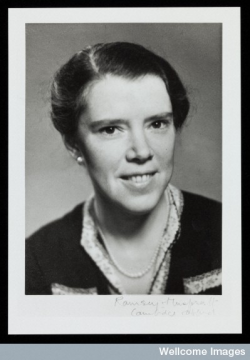Dame Honor Fell

Honor Fell. Image courtesy of the Wellcome Library, London
- Born
- 22 May 1900
- Died
- 22 April 1986 (age 85)
Dame Honor Fell pioneered the study of living cells under the microscope and developed the organ culture method. Her most significant work was on the immune system and its role in rheumatoid arthritis. She made fundamental contributions to the knowledge of skeletogenesis (the formation of skeletons).
The organ culture method allowed scientists to grow differentiated cells which mimicked the behaviour of organs in the body. It meant they could test the reaction of cells to beneficial or adverse substances, without exposing living humans to risk.
Fell’s research interest was in applied cell biology, particularly the development and degradation of animal tissue. Fell inherited her interest in biology and animals from her father. She kept ferrets as a child and took her favourite ferret along to her sister’s wedding. Caring for these animals gave her a chance to hone her zoological skills.
She went on to study zoology at the University of Edinburgh and stayed there to do her PhD. It was during this time that Professor Francis Crew, director at the Institute of Animal Breeding, recognised her potential and recommended she spend some time at Strangeways with Dr T S P Strangeways to learn the techniques of tissue culture. It was then a small laboratory investigating arthritis.
She became director of the Strangeways Laboratory when she was in her twenties, at a time when there were few women professionals in science and she held this position for more than 40 years.
Fell developed the laboratory from a small concern to a major institute known worldwide. This was aided by her decision to provide study facilities for scientists who were refugees from the Second World War. She also managed research grants from the Medical Research Council and oversaw the contruction of a new wing in 1938, funded by the Rockefeller Foundation, which contributed to its growth.
This work is of outstanding merit and is now recognised as one of the fundamental contributions to the knowledge of skeletogenesis
Certificate of a candidate for election to the Royal Society, 1952
The laboratory became known for tissue culture in developmental biology, skeletal tissue metabolism and cancer research. The development of radiobiology (the effects of X-rays on living animal tissue) was pioneered here and some of the first cine films, showing the separation of pairs of chromosomes, were made at Strangeways.
Fell provided Francis Crick with his first biological research project and secured him a post at the laboratory in 1947. Crick went on to discover the structure of the DNA molecule with James Watson in 1953.
Fell, through her pioneering studies on cartilage and bone formation, is regarded as one of the founder figures in the field of matrix biology (the study of the structural support for cells in the body) . Fell was awarded honorary life membership of the British Connective Tissue Society (now the British Society of Matrix Biology) at its inaugural AGM at York in 1982. The Society’s most prestigious honour, The Fell Muir Award, was named in recognition of Dame Honor Fell’s (and Dame Helen Muir’s) contributions to Matrix Biology.
Fell retired at the age of 70, as was the custom, but continued her research when the head of the Pathology Department at Cambridge made some space for her in his lab. She worked there and was still experimenting in her home laboratory in the year she died.



